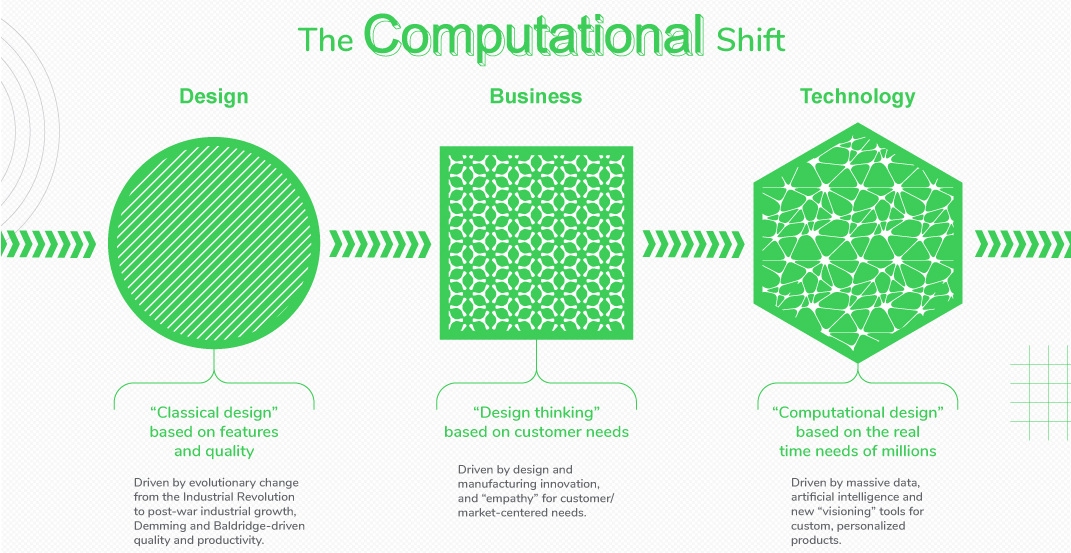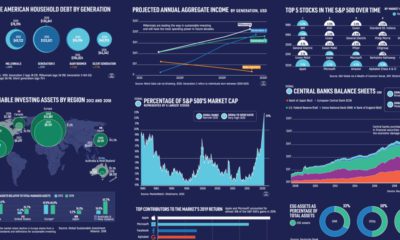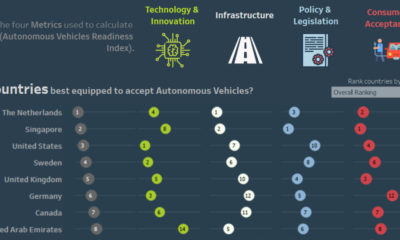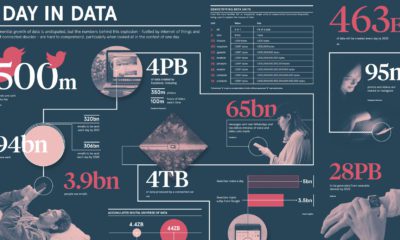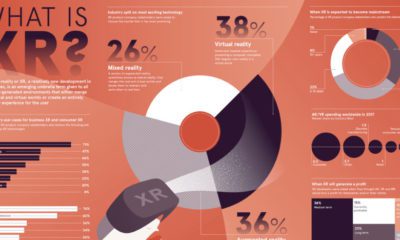Imagining the Future of Design and Collaboration
New technologies are getting adopted faster and faster. In the modern business environment, it no longer takes multiple decades for new ideas to take root. Instead, thanks to increased connectivity, instantaneous communication, and big leaps in computing power, these new innovations can rise to prominence in much shorter time spans. As these changes surface, companies can either help pioneer these new technologies – or they can be caught off guard by their impact on industry.
A Fundamental Shift
Today’s infographic comes to us from Schneider Electric, and it dives into the many technological forces that will be re-shaping the future of design and collaboration. It touches on an exciting but uncertain future for industrial designers, architects, engineers, and other design-oriented industries, in which rising processing power and new technologies are re-wiring the fundamental relationship between the designer and the end product. Almost certainly, these forces will shape a competitive landscape for the design industry that will seem almost completely unfamiliar over the next decade or so.
The Computational Era
Computer-aided design (CAD) has already revolutionized design, but it turns out that CAD only scratches the surface of what is possible with computers. The rapid increase in processing power, the miniaturization of devices, new algorithms, and increased connectivity are leading to a new era of computational design. Instead of designers using computers as a tool, computers are now able to generate insights, make creative leaps, and jump to decisions using massive data sets – and this will fundamentally change the designer’s role in the creative process. In the future, designers will be more like mentors for computers by providing their guidance and experience.
The Forces Shaping Design
What do we mean when we say “computational design”? Infinite computing Tapping into cloud-based computing power to try thousands of design permutations. Big data & predictive analytics Using billions of data points and predictive analytics to create new or highly customized products. Generative design Computers mimic nature’s evolutionary approach to design. AI / Machine learning Designing a system that learns and adapts over time.
The Forces Shaping Collaboration
But how design is changing doesn’t stop there – how we collaborate on design is also undergoing a revolution: AR/VR Virtual collaboration can be achieved across the globe, allowing designers to work in parallel. Cloud-based collaboration Design is no longer siloed and can be democratized between different stakeholders. Further, teams can work simultaneously from all over the world. Crowdsourcing Input for design and specialized parts can be crowdsourced. 3d and 4d printing Design and manufacturing can be integrated seamlessly, even to customize individual items. 4d printing is a new frontier where printed objects adapt to various circumstances.
An Uncertain Future
Data, computing power, and new tools are enabling a rapid transition in how we design and collaborate. No one can be certain about how different the future of design and collaboration will be, or how it will affect business models – but for companies to remain relevant and competitive over the coming years, they will need to be watching this technological revolution very closely.
on But fast forward to the end of last week, and SVB was shuttered by regulators after a panic-induced bank run. So, how exactly did this happen? We dig in below.
Road to a Bank Run
SVB and its customers generally thrived during the low interest rate era, but as rates rose, SVB found itself more exposed to risk than a typical bank. Even so, at the end of 2022, the bank’s balance sheet showed no cause for alarm.
As well, the bank was viewed positively in a number of places. Most Wall Street analyst ratings were overwhelmingly positive on the bank’s stock, and Forbes had just added the bank to its Financial All-Stars list. Outward signs of trouble emerged on Wednesday, March 8th, when SVB surprised investors with news that the bank needed to raise more than $2 billion to shore up its balance sheet. The reaction from prominent venture capitalists was not positive, with Coatue Management, Union Square Ventures, and Peter Thiel’s Founders Fund moving to limit exposure to the 40-year-old bank. The influence of these firms is believed to have added fuel to the fire, and a bank run ensued. Also influencing decision making was the fact that SVB had the highest percentage of uninsured domestic deposits of all big banks. These totaled nearly $152 billion, or about 97% of all deposits. By the end of the day, customers had tried to withdraw $42 billion in deposits.
What Triggered the SVB Collapse?
While the collapse of SVB took place over the course of 44 hours, its roots trace back to the early pandemic years. In 2021, U.S. venture capital-backed companies raised a record $330 billion—double the amount seen in 2020. At the time, interest rates were at rock-bottom levels to help buoy the economy. Matt Levine sums up the situation well: “When interest rates are low everywhere, a dollar in 20 years is about as good as a dollar today, so a startup whose business model is “we will lose money for a decade building artificial intelligence, and then rake in lots of money in the far future” sounds pretty good. When interest rates are higher, a dollar today is better than a dollar tomorrow, so investors want cash flows. When interest rates were low for a long time, and suddenly become high, all the money that was rushing to your customers is suddenly cut off.” Source: Pitchbook Why is this important? During this time, SVB received billions of dollars from these venture-backed clients. In one year alone, their deposits increased 100%. They took these funds and invested them in longer-term bonds. As a result, this created a dangerous trap as the company expected rates would remain low. During this time, SVB invested in bonds at the top of the market. As interest rates rose higher and bond prices declined, SVB started taking major losses on their long-term bond holdings.
Losses Fueling a Liquidity Crunch
When SVB reported its fourth quarter results in early 2023, Moody’s Investor Service, a credit rating agency took notice. In early March, it said that SVB was at high risk for a downgrade due to its significant unrealized losses. In response, SVB looked to sell $2 billion of its investments at a loss to help boost liquidity for its struggling balance sheet. Soon, more hedge funds and venture investors realized SVB could be on thin ice. Depositors withdrew funds in droves, spurring a liquidity squeeze and prompting California regulators and the FDIC to step in and shut down the bank.
What Happens Now?
While much of SVB’s activity was focused on the tech sector, the bank’s shocking collapse has rattled a financial sector that is already on edge.
The four biggest U.S. banks lost a combined $52 billion the day before the SVB collapse. On Friday, other banking stocks saw double-digit drops, including Signature Bank (-23%), First Republic (-15%), and Silvergate Capital (-11%).
Source: Morningstar Direct. *Represents March 9 data, trading halted on March 10.
When the dust settles, it’s hard to predict the ripple effects that will emerge from this dramatic event. For investors, the Secretary of the Treasury Janet Yellen announced confidence in the banking system remaining resilient, noting that regulators have the proper tools in response to the issue.
But others have seen trouble brewing as far back as 2020 (or earlier) when commercial banking assets were skyrocketing and banks were buying bonds when rates were low.

